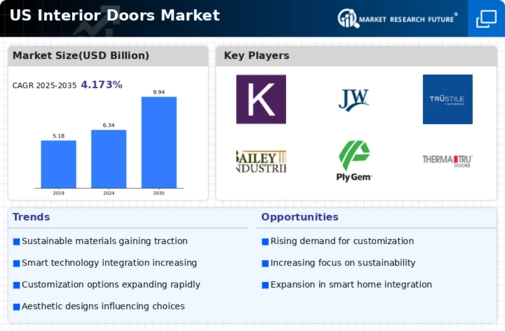Growth in Home Renovation Projects
The interior doors market is significantly impacted by the ongoing growth in home renovation projects across the United States. As homeowners invest in upgrading their living spaces, the demand for new and stylish interior doors rises. According to recent data, the home renovation market is expected to grow at a CAGR of 4.5% through 2027, which directly correlates with increased sales in the interior doors market. Renovation projects often include replacing outdated doors with modern alternatives that enhance both functionality and design. This trend indicates a robust opportunity for manufacturers within the interior doors market to capitalize on the renovation wave, providing innovative solutions that meet evolving consumer preferences.
Rising Demand for Aesthetic Appeal
The interior doors market experiences a notable surge in demand driven by the increasing emphasis on aesthetic appeal in residential and commercial spaces. Homeowners and designers are increasingly prioritizing the visual aspects of interior doors, seeking styles that complement overall decor. This trend is reflected in the market, where the value of decorative interior doors is projected to reach approximately $3 billion by 2026. The desire for unique designs, finishes, and colors is influencing manufacturers to innovate and diversify their product offerings. As a result, the interior doors market is adapting to meet these aesthetic preferences, which may lead to a broader range of products that cater to various design themes.
Urbanization and Population Growth
Urbanization and population growth are key drivers influencing the interior doors market. As more individuals and families move to urban areas, the demand for housing and, consequently, interior doors increases. The U.S. Census Bureau projects that urban populations will continue to rise, leading to a greater need for residential and commercial construction. This trend is likely to stimulate the interior doors market, as builders and developers seek to incorporate modern and stylish doors into new projects. Additionally, the growing population may lead to a diversification of housing types, further expanding the market for various door styles and functionalities.
Increased Focus on Energy Efficiency
The interior doors market is witnessing a shift towards energy-efficient products as consumers become more environmentally conscious. Energy-efficient doors contribute to better insulation and reduced energy costs, appealing to a growing segment of eco-aware buyers. The market for energy-efficient interior doors is projected to expand, with estimates suggesting a growth rate of around 6% annually. This trend is prompting manufacturers to develop doors that not only meet aesthetic demands but also provide energy-saving benefits. The interior doors market is likely to see increased competition as companies innovate to create products that align with sustainability goals while maintaining style and functionality.
Technological Advancements in Manufacturing
Technological advancements are reshaping the interior doors market, enabling manufacturers to produce high-quality products more efficiently. Innovations in materials and production techniques, such as the use of advanced composites and automated manufacturing processes, are enhancing the durability and design of interior doors. This evolution is expected to drive down production costs while improving product quality, potentially leading to a more competitive pricing landscape. As a result, the interior doors market is likely to benefit from increased accessibility to a wider range of consumers, including those seeking premium options at more affordable prices. The integration of technology in manufacturing processes may also lead to faster turnaround times for custom orders.

















Leave a Comment